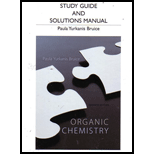
Interpretation:
The given compounds should be listed in the order of highest boiling to lowest boiling.
Concept introduction:
Boiling points: The every chemical compounds is the particular temperature at which its liquid from becomes a gas or (vaporizes). For a compound to vaporize, the forces that hold the individual molecules close to each other in the liquid must be overcome.
Than the boiling point of a each compound depends on the strength of the attractive forces between the individual molecules. If the molecules are held together by strong force then a great deal of energy will be need to pull the molecules away from each other and the compound will have a high boiling point.
On the other hand, if the molecules are held together by weak forces only a small of energy be need to pull the molecules away from each other and the compound will have a low boiling point.
Dipole interaction: The boiling points of all organic molecules like (ether,
Want to see the full answer?
Check out a sample textbook solution
Chapter 3 Solutions
Organic Chemistry
- List the following compounds from highest boiling to lowest boiling:arrow_forwardArrange the following compounds in order of increasing boiling pointarrow_forwardOrder the following chemicals from lowest boiling point to highest boiling point Highest boiling point 1 2 3 4 Acetone Propanol Propanal Butane Lowest boiling pointarrow_forward
- Arrange the compounds from highest boiling point to lowest boiling point.arrow_forwardArrange the following compounds in order of increasing boiling points. Clear All CH-CHa-CH2-CHz-СHз lowest boiling point CHз CH—с—снНз intermediate boiling point ČH3 CHз highest boiling point CH3-CH-CH2-CH3arrow_forwardWhich of the two has a higher boiling point: Propanol or Pentanol?arrow_forward
- Place the following substances lowest to highest boiling point. Explain your answer. CH3CH2OH CH3OCH3 H2Oarrow_forwardConsider the compounds CH₃OCH₃, CH₃CH₂OH, CH₃CH₂CH₃. Arrange the following compounds from lowest to highest boiling point. Explain your basis of ordering.arrow_forwardArrange the following compounds in order of increasing boiling point. CH3CH₂ CH3 CH₂C-H CH₂CH₂OH Clear All Lowest boiling point Intermediate boiling point Highest boiling pointarrow_forward
 Chemistry for Today: General, Organic, and Bioche...ChemistryISBN:9781305960060Author:Spencer L. Seager, Michael R. Slabaugh, Maren S. HansenPublisher:Cengage Learning
Chemistry for Today: General, Organic, and Bioche...ChemistryISBN:9781305960060Author:Spencer L. Seager, Michael R. Slabaugh, Maren S. HansenPublisher:Cengage Learning Organic ChemistryChemistryISBN:9781305580350Author:William H. Brown, Brent L. Iverson, Eric Anslyn, Christopher S. FootePublisher:Cengage Learning
Organic ChemistryChemistryISBN:9781305580350Author:William H. Brown, Brent L. Iverson, Eric Anslyn, Christopher S. FootePublisher:Cengage Learning

